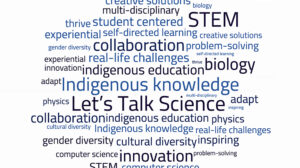For the past two decades, reading resources and programs that minimize the use of phonics and decoding have dominated the North American educational market. Over the same period, cognitive scientists repeatedly warned that the methods of teaching used in these popular products were not well supported by evidence. But the majority of teachers and decision makers in our schools ignored these warnings and enthusiastically embraced unscientific theories of learning.
Fortunately, for students, the science of reading has finally begun to influence the way we teach reading and there is now widespread agreement among educators on what methods are in line with the science of learning.
Unfortunately for students, as evidenced by more than a decade of flat and declining math scores across North America, the science of teaching math has not received similar attention and there is little agreement among educators about how to teach it effectively. In fact, the major scientific findings on how math should be taught are so out of line with present approaches that it may be many years before we can improve the teaching of math. In the meantime, publishers of math resources that are not aligned with this research will undoubtedly continue to claim that their products are “evidence-based” or “evidence informed.”
So, how can educators learn about the research that underpins effective math instruction so they can choose truly evidence-based programs and give students the best chance to succeed at math? Let’s explore three important markers of effective math instruction that are now well established by research. Math programs that ignore any of these principles are not likely aligned with the science of learning.
Using Abstract Examples
The most widely used math resources in Canada and the US were created by educators who believe that problem-solving is best taught using rich, rigorous “real world” applied problems. However, in 2008, cognitive scientist Jennifer Kaminski published a ground-breaking paper in Science magazine entitled, The Advantages of Abstract Examples in Learning Math. In her study, Kaminski found that students are more likely to transfer knowledge (by applying a concept in a new situation) if they learn the concept from a generic or abstract instantiation than if they learn the concept from multiple concrete instantiations. As well, research on “concreteness fading,” has shown that even in cases where children can benefit from exposure to concrete instantiations, students whose teachers quickly move to more abstract models do better at solving real world problems!
Most educators are unaware of this body of scientific research. Our schools may have created a generation of students who have trouble applying math in the world because educators consistently overvalue concrete approaches and “real world,” “authentic” problems when they teach problem-solving. There’s no denying that students need to be given many opportunities to solve real world problems, but research suggests that they develop the capacity to solve these problems through exposure to more abstract representations.
Kaminski and her coworkers have conducted numerous studies on the advantages of abstract approaches to math instruction with students of all ages, from preschool to university that are available online. A detailed explanation of how to teach problem-solving using a more abstract approach can also be found in chapter 5 of the book, All Things Being Equal: Why Math is the Key to a Better World.
Cognitive Load Theory
Research in cognitive load theory and other areas of cognitive science suggests that there is an optimal zone for learning and that most people can usually only handle one or two small conceptual variations at a time when they are learning something new.
Over the past five years, hundreds of teachers participating in math pilots in Ontario and Alberta were asked which method of teaching chess they think would be more effective. Method 1: Students play the full game of chess from the beginning of the year: the teacher gives students some coaching and allows stronger players to help weaker players, but children learn primarily by playing the game. Method 2: Students start by playing “mini-games” with only a few pieces. These games have been designed by experts to help students develop “mental representations” so they can, for example, visualize how the various pieces move or quickly see which of several positions is stronger. In a typical mini-game, white might have a king and a castle and black a king. The challenge for white is to checkmate in three moves. As students master these challenges, the teacher introduces more complex scenarios and children eventually play the full game.
Almost all of the teachers surveyed picked the second method of instruction as more effective. This shows that teachers’ intuitions are more closely aligned with the science of learning than the math resources they are required to use. In most popular math programs, the problems that students are expected to solve in the first half of the year have the same level of complexity (and density of language) as the problems they are expected to solve in the second half of the year. But research suggests that students benefit from a more incremental approach to problem-solving. Novice learners need help attending to the salient features of the problem (which abstract examples make clear) and more scaffolding and practice than expert learners. A large-scale meta-analysis by researchers Alfieri et al (2011) showed that students learn more in lessons where the teacher guides inquiry (using scaffolding, worked examples, practice and elicited explanations) than from less structured discovery-based lessons.
These findings are in line with research suggesting that students learn most efficiently when they are given problems that are just challenging enough to trigger the brain’s natural dopamine-opioid motivational cycle but aren’t so challenging that they cause students to give up.
A new study in Nature Communications, The 85 percent rule for optimal learning, presents evidence that optimal learning is achieved when learners engage with tasks at which they have an 85% accuracy rate. Training at this level dramatically improves the rate of learning.
By introducing too many new skills and concepts at the same time, most mainstream math programs consistently cause “cognitive overload”, requiring students to work in a zone where they have a very low rate of accuracy. A well-designed math program should keep students in the optimal “Goldilocks zone” and gradually expand the boundaries of this zone as students become more confident and proficient problem solvers.
Impact of Inefficient Methods of Instruction on Mindsets and Social Emotional Learning
American psychologist and author, Carol Dweck, whose research on mindsets is widely known, showed that students who have “growth mindsets” (who believe they can get better through practice) tend to do better at school than students with “fixed mindsets” (who believe they need to be born with a gift to do well at something).
Math programs that consistently push students outside of their zone of productive struggle are likely to undermine any work that a teacher wants to do to help students develop greater confidence in math or more productive mindsets. A teacher who tells their students that they can get better with practice, immediately contradicts this message by demonstrating, through highly inefficient teaching methods, that the significant majority of students can’t get better with practice!
Inefficient methods of teaching also exacerbate visible hierarchies in the classroom and make it harder for teachers to close the gap between students. As early as kindergarten children start to compare themselves to their peers and to identify some as talented or “smart” in various subjects. Children who decide that they are not talented will often stop paying attention or making an effort to do well. This problem is likely to compound more quickly in math than in other subjects because when you miss a step in math it is usually impossible to understand what comes next. The cycle is vicious: the more a student fails, the more their negative view of their abilities is reinforced and the less efficiently they learn.
For further reading on the research discussed in this article, there are many well-written and informative articles on these and other topics on the Internet. Look for articles that are published in science journals rather than education journals, as the level of evidence required for publication in science journals is generally higher. Most articles on education in science journals are accessible and the findings easy to understand. Principles of Instruction by Barak Rosenshine, first published in American Educator for teachers and school administrators, outlines 10 principles of effective instruction and references an extensive bibliography of articles published in scientific journals.
Before adopting a math program, ask if any articles on the effectiveness of the program have been published in peer-reviewed science journals, read up on the latest research, and let’s turn the page on unscientific instruction to enable better math outcomes for all our students.
ABOUT THE AUTHOR:
John Mighton, PhD, O.C., Award-winning mathematician, author and Founder, JUMP Math











